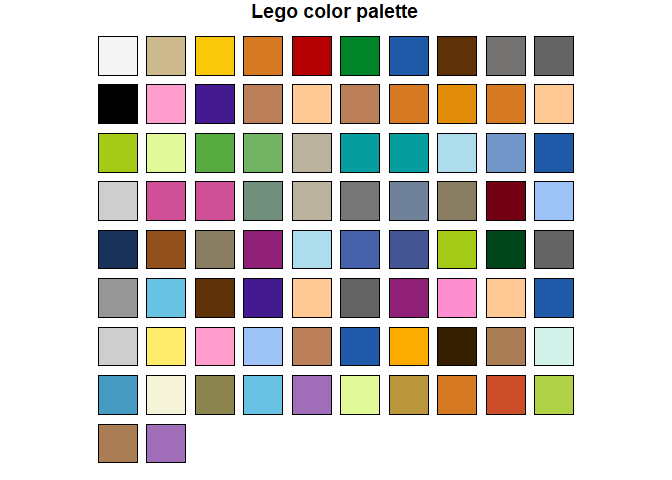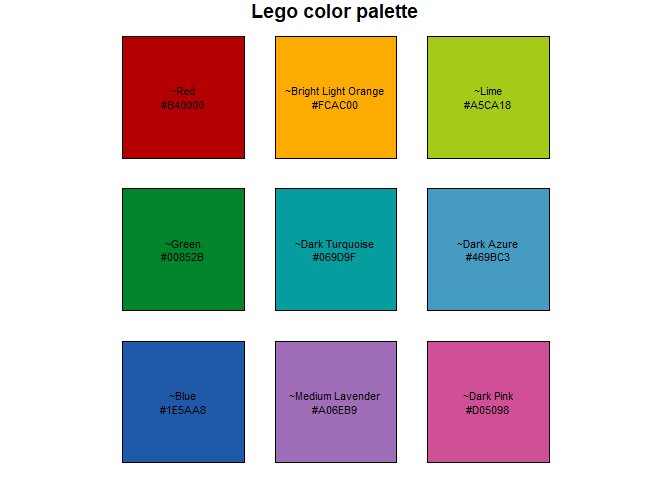

legocolors provides a dataset containing several Lego
color naming conventions established by various popular sources. It also
provides functions for mapping between these color naming conventions as
well as between Lego color names, hex colors, and R color names.
By default, nearest colors are computed based on distance in RGB
space when an exact match is not found. This behavior supports the
purpose of exchanging arbitrary colors for known Lego colors when the
goal is to actually acquire and build something out of Lego parts. This
focus is also one of the reasons legocolors uses BrickLink
color names as the default naming convention. See
?legocolor for details.
Install the CRAN release of legocolors with
install.packages("legocolors")Install the development version from GitHub with
# install.packages("remotes")
remotes::install_github("leonawicz/legocolors")The key helper functions are hex_to_legocolor() and
legocolor_to_hex(). hex_to_color() is also
provided for general convenience.
library(legocolors)
hex_to_color(c("#ff0000", "#ff0001"))
#> [1] "red" "~red"
hex_to_legocolor("#ff0000")
#> [1] "~Trans-Red"
hex_to_legocolor("#ff0000", material = "solid")
#> [1] "~Red"
legocolor_to_hex("Red")
#> [1] "#B40000"
hex_to_color(legocolor_to_hex("Red"))
#> [1] "~red3"
x <- topo.colors(10)
hex_to_legocolor(x)
#> [1] "~Dark Purple" "~Blue"
#> [3] "~Trans-Dark Blue" "~Medium Azure"
#> [5] "~Bright Green" "~Lime"
#> [7] "~Glitter Trans-Neon Green" "~Trans-Yellow"
#> [9] "~Trans-Neon Green" "~Light Nougat"
hex_to_legocolor(x, material = "solid")
#> [1] "~Dark Purple" "~Blue" "~Dark Azure"
#> [4] "~Medium Azure" "~Bright Green" "~Lime"
#> [7] "~Yellow" "~Yellow" "~Bright Light Yellow"
#> [10] "~Light Nougat"
hex_to_legocolor(x, def = "tlg", material = "solid")
#> [1] "~Medium Lilac" "~Bright Blue"
#> [3] "~Dark Azur" "~Medium Azur"
#> [5] "~Bright Green" "~Bright Yellowish Green"
#> [7] "~Bright Yellow" "~Bright Yellow"
#> [9] "~Cool Yellow" "~Light Nougat"While different sets of Lego colors are organized by
material type, e.g., solid colors, semi-transparent colors,
etc., these palettes are not useful for plotting data. The greatest
value comes from converting useful color palettes to those comprised of
existing Lego colors while still keeping as close to the original
palette as possible.
The view_legopal function can be used to quickly see a
Lego color palette. It can plot a named material palette,
but like the functions above, it can also display a converted palette if
given an arbitrary vector of hex color values.
view_legopal("solid")
r <- rainbow(9)
r
#> [1] "#FF0000" "#FFAA00" "#AAFF00" "#00FF00" "#00FFAA" "#00AAFF" "#0000FF"
#> [8] "#AA00FF" "#FF00AA"
view_legopal(r, material = "solid", show_labels = TRUE, label_size = 0.7)
Dealing with
Filtering to a decent set of Lego colors that are relatively easy to
acquire online at BrickLink.com for simple brick and/or plate parts, and
relatively affordable, is largely the responsibility of the user. There
is a recommended column in the legoCols
dataset. However, a human-derived recommendation column would be better
(feel free to submit a PR if you’d like to improve the package).
In the previous version of legocolors, brick- and plate-
specific data, excluding more exotic parts, was scraped from the website
catalog, but this has become too difficult to do reliably. For now, you
will have to use your personal Lego knowledge to filter out irrelevant
or problematic colors from the complete official set. This is worth
considering because even though BrickLink consistently offers the widest
selection and greatest quantity at the lowest price, supply and demand
leads to some parts in some colors being prohibitively expensive to
acquire in quantity. When determining what colors you wish to use to
build a physical model, you will save an incredible amount of money if
you can accept limiting your palette to the most common Lego colors.
Matthew Leonawicz (2024). legocolors: Official Lego Color Palettes. R package version 0.4.0. https://CRAN.R-project.org/package=legocolors
Contributions are welcome. Contribute through GitHub via pull request. Please create an issue first if it is regarding any substantive feature add or change.
Please note that the legocolors project is released with
a Contributor
Code of Conduct. By contributing to this project, you agree to abide
by its terms.